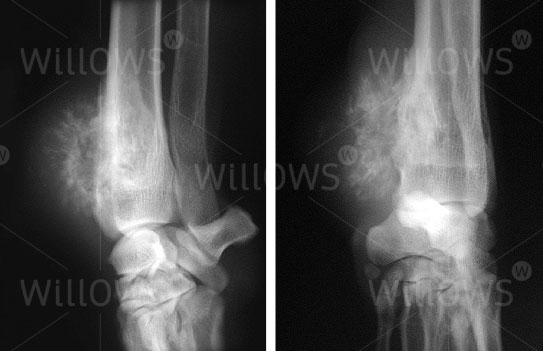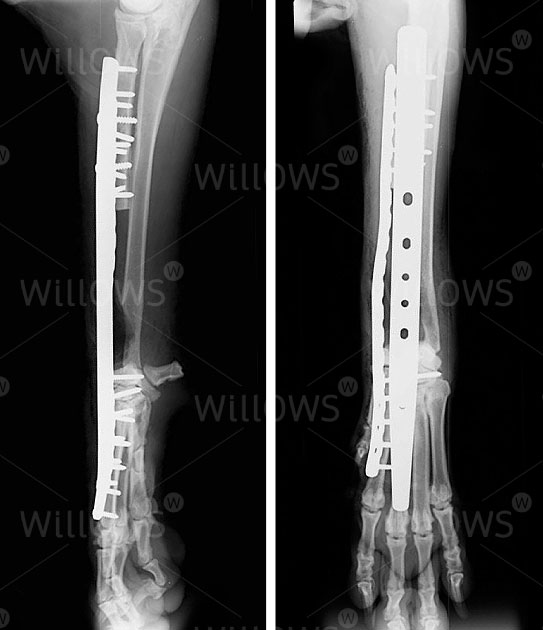Why Should I Bring my Pet to Willows for Treatment of Osteosarcoma?
Willows is one of Europe’s leading small animal Orthopaedic referral centres treating over 1000 new patients a year. Our state-of-the-art hospital is led by internationally renowned Specialists committed to providing the highest standards of care. Our team of Orthopaedic Specialists have extensive experience of successfully treating thousands of different fractures, and have published many of results in peer-reviewed journals.
Our Orthopaedic Surgeons are supported by our multi-disciplinary team of Specialists across a number of disciplines including; Anaesthesia, Diagnostic Imaging and Emergency and Critical Care. Willows has a large dedicated team of Nurses and clinical support staff available 24 hours a day, every day of the year to provide the best possible care for your pet.
What is Osteosarcoma?
Osteosarcoma is a cancer that originates in bone tissue. In dogs the most commonly affected bones are the upper arm (humerus), forearm (radius/ulna), thigh (femur) and shin (tibia). Other bones, such as those of the skull, spine, shoulder blade (scapula) and pelvis, are less frequently affected. Large and giant breeds are much more likely to develop an osteosarcoma than medium and small breeds. In dogs, osteosarcoma affecting the long bones tends to be highly malignant with spread (metastasis) of cancer cells to other parts of the body, especially the lungs.
What are the Signs of Osteosarcoma?
Osteosarcoma affecting the upper arm, forearm, thigh or shin will typically cause bone pain and lameness. The lameness tends to get worse with time and responds poorly to conventional pain killing drugs. As the tumour grows it may result in a swelling of the bone that can be seen or felt. In advanced cases, the cancer may weaken the bone to such an extent that it fractures.

How is Osteosarcoma Diagnosed?
X-ray is the most common way to diagnose osteosarcoma, advanced imaging techniques such as a CT scan may provide additional information, including the extent of bone involvement. X-rays or a CT scan of the chest and an ultrasound scan of the abdomen may be performed to look for evidence that the tumour has spread. A definitive diagnosis of osteosarcoma requires a sample of tissue being obtained (a biopsy) and examined microscopically. Blood tests may also be performed to assess the patient’s general health and fitness for treatment.
Fig 1: X-rays showing destruction of bone and irregular new bone formation in a Great Dane with an osteosarcoma affecting the end of the forearm


What are Treatments are Available for Osteosarcoma?
Painkillers are given to reduce discomfort from the affected bone. Amputation of the affected limb provides rapid pain relief and is a good option in dogs that have no significant problems with their other three limbs. Even giant breed dogs rapidly adapt to losing a limb, and client satisfaction about their dog’s wellbeing is generally high following this type of surgery. However, as the cancer has generally already spread to other parts of the body by the time of diagnosis, the chance of the dog surviving six months following amputation without subsequent chemotherapy is less than 50%.
Surgical alternatives to amputation include techniques which remove the tumour but preserve the limb (referred to as ‘limb sparing’). The cancerous section of bone may be removed, and metal plates and screws are used to bridge the cancer site. Limb sparing is most commonly used when an osteosarcoma affects the bottom of the forearm and limb function is generally very good, with average survival times similar to those following amputation.
Fig 2: Post- surgery X-rays of a Newfoundland with osteosarcoma of the forearm. The tumour has been cut out and the gap in the bone bridged with two plates that are attached to the remaining bones with multiple screws. The wrist joint has been fused.
What can I Expect if my Pet is Treated for Osteosarcoma?
In view of the high likelihood of osteosarcoma tumour cells having spread to other parts of the body, chemotherapy is almost always recommended after either amputation or limb sparing surgery. This involves administering one or more anti-cancer drugs which aim to increase survival, but at the same time minimise side effects and maintain a good quality of life. In general, chemotherapy when combined with surgery results in a two-fold increase in survival time compared to surgery alone, although there is a small number of dogs that achieve much longer survival times than this.
When osteosarcoma affects the lower jaw bone (mandible), upper jaw bone (maxilla) skull or nose the treatment typically comprises surgery, with or without radiation therapy. Osteosarcoma affecting these sites may have a better long-term outcome, but this varies widely depending on the location and size of the tumour.
To save this page as a PDF, click the button and make sure “Save as PDF” is selected.
Cancer Care
Find out more
To assist owners in understanding more about Cancer Care we have put together a range of information sheets to talk you through the some of the more common conditions seen and treated by our Specialists.

